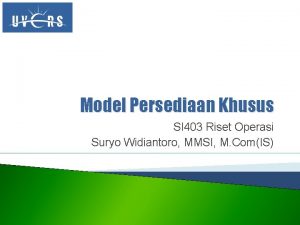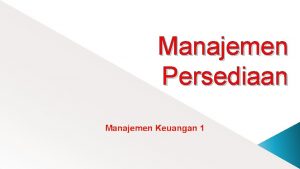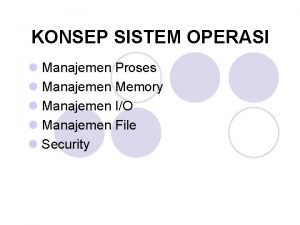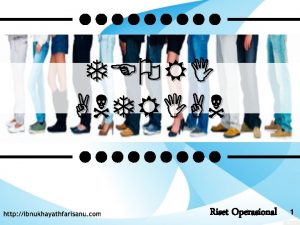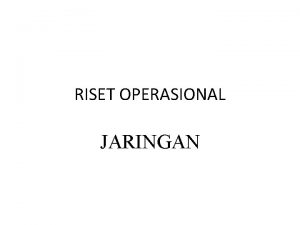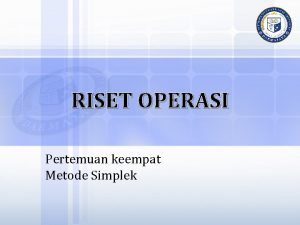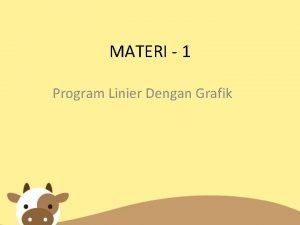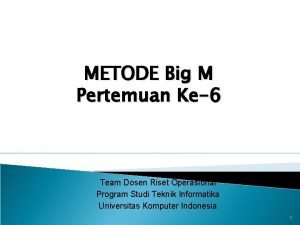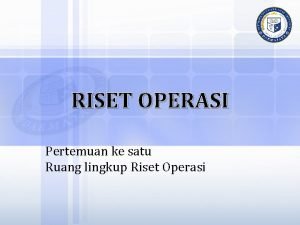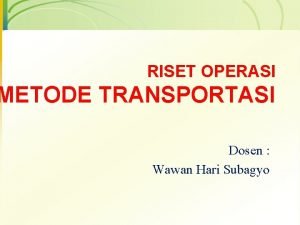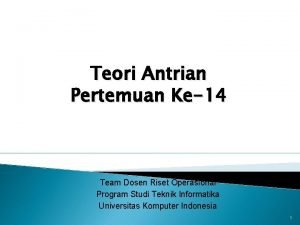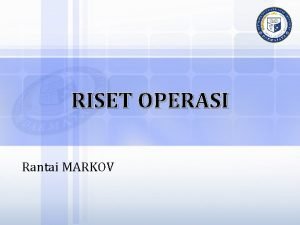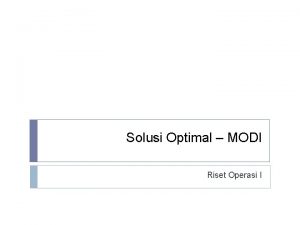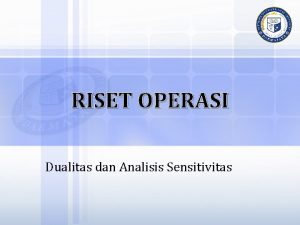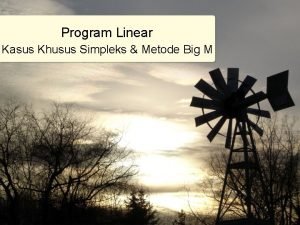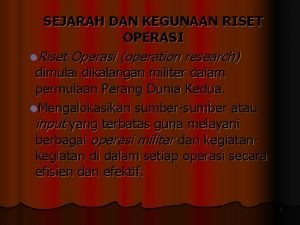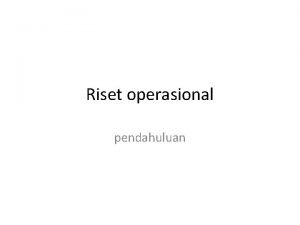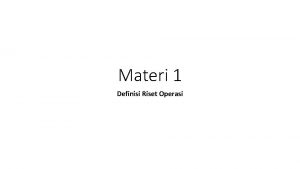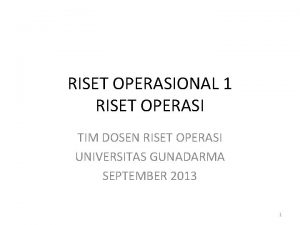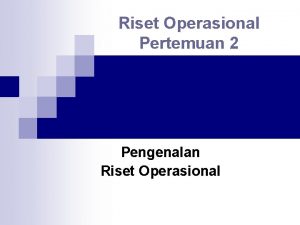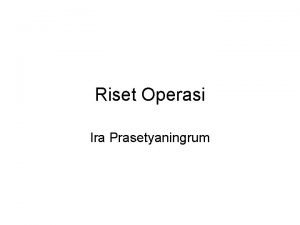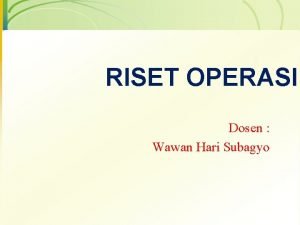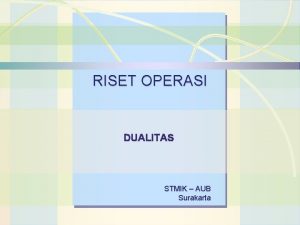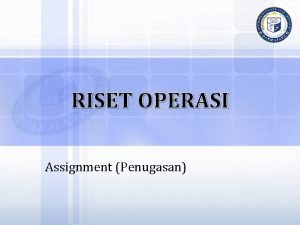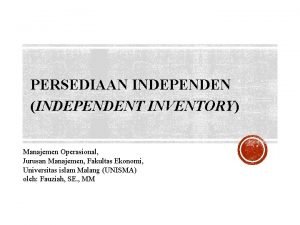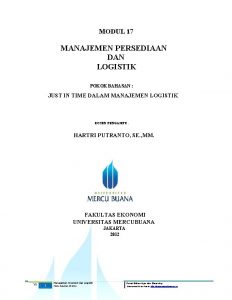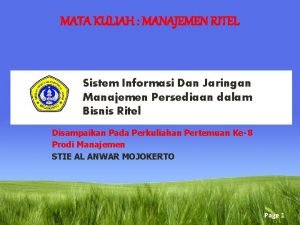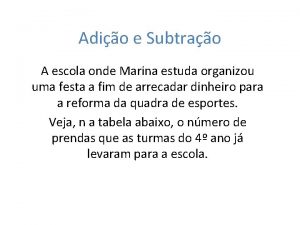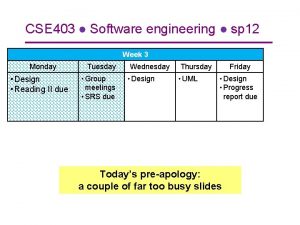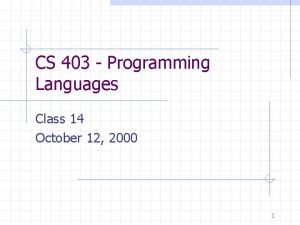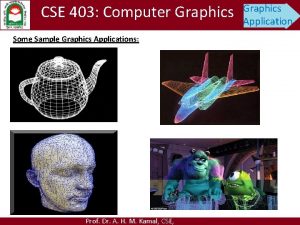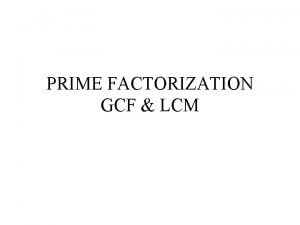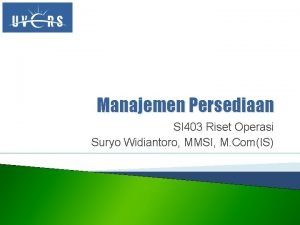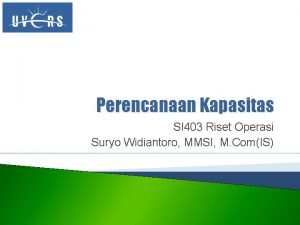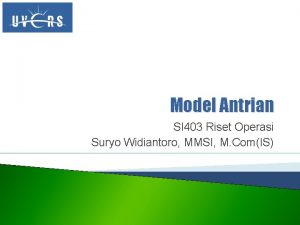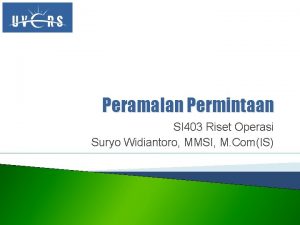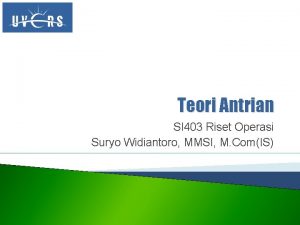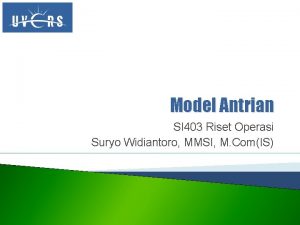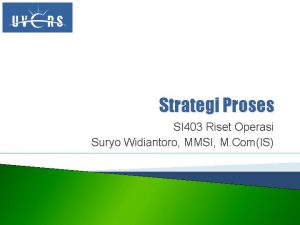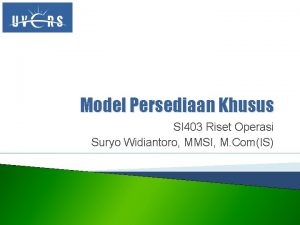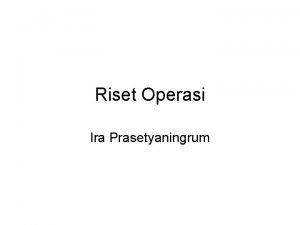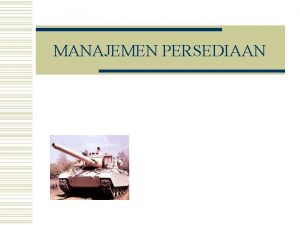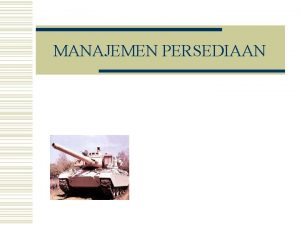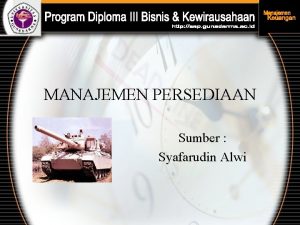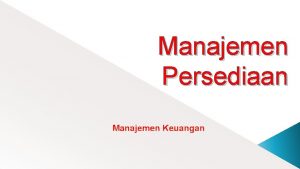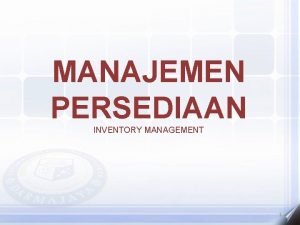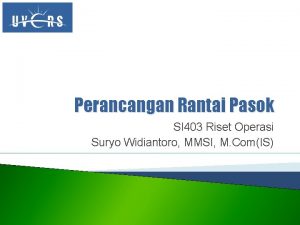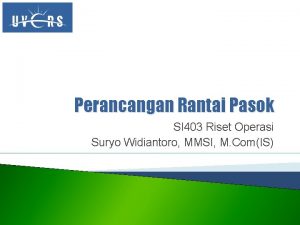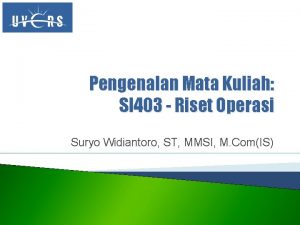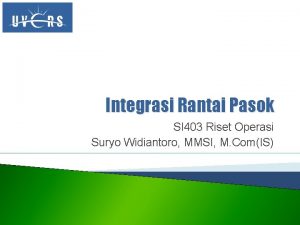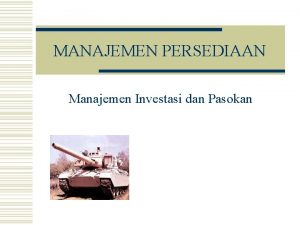Manajemen Persediaan SI 403 Riset Operasi Suryo Widiantoro


































- Slides: 34

Manajemen Persediaan SI 403 Riset Operasi Suryo Widiantoro, MMSI, M. Com(IS)

Capaian Pembelajaran Materi Perkuliahan � Mahasiswa mampu melakukan perencanaan untuk memastikan kelancaran operasi rantai pasok

Topik Bahasan 1. 2. 3. Manajemen persediaan dalam organisasi Persediaan dan rantai pasok Manajemen persediaan

� Inventory management, the planning and controlling of inventories in order to meet the competitive priorities of the organization, is an important concern for managers in all types of businesses. � Effective inventory management is essential for realizing the full potential of any supply chain. � The challenge is not to pare inventories to the bone to reduce costs or to have plenty around to satisfy all demands, but to have the right amount to achieve the competitive priorities of the business most efficiently. � This type of efficiency can only happen if the right amount of inventory is flowing through the supply chain—through suppliers, the firm, warehouses or distribution centers, and customers.

� Much of inventory management involves lot sizing, which is the determination of how frequently and in what quantity to order inventory. � We make ample reference to the term lot size, which is the quantity of an inventory item management either buys from a supplier or manufactures using internal processes.

Manajemen persediaan dalam organisasi

� Inventories are important to all types of organizations, their employees, and their supply chains. ◦ Inventories profoundly affect everyday operations because they must be counted, paid for, used in operations, used to satisfy customers, and managed. � Inventories require an investment of funds, as does the purchase of a new machine. ◦ Monies invested in inventory are not available for investment in other things; thus, they represent a drain on the cash flows of an organization. � Companies realize that the availability of products is a key selling point in many markets and downright critical in many more.

� Certainly, too much inventory on hand reduces profitability, and too little inventory on hand creates shortages in the supply chain and ultimately damages customer confidence. � Inventory offs. management, therefore, involves trade-

Persediaan dan rantai pasok

� The flow of materials determines inventory levels. � Inventory is a stock of materials used to satisfy customer demand or to support the production of services or goods.

�A fundamental question in supply chain management is how much inventory to have. � The answer to this question involves a tradeoff between the advantages and disadvantages of holding inventory. � Depending on the situation, the pressures for having small inventories may or may not exceed the pressures for having large inventories.

Pressures for Small Inventories � An inventory manager’s job is to balance the advantages and disadvantages of both small and large inventories and find a happy medium between the two levels. � The primary reason for keeping inventories small is that inventory represents a temporary monetary investment. � As such, the firm incurs an opportunity cost, which we call the cost of capital, arising from the money tied up in inventory that could be used for other

� The inventory holding cost (or carrying cost) is the sum of the cost of capital plus the variable costs of keeping items on hand, such as storage and handling costs and taxes, insurance, and shrinkage costs. � When these components change with inventory levels, so does the holding cost. � Companies usually state an item’s holding cost period of time as a percent of its value. ◦ The annual cost to maintain one unit in inventory typically ranges from 15 to 35 percent of its value.

Pressures for Large Inventories � Pressures related to maintaining large inventories: 1. Customer Service A stockout is an order that cannot be satisfied, resulting in loss of the sale. A backorder is a customer order that cannot be filled when promised or demanded but is filled later. 2. Ordering Cost The cost of preparing a purchase order for a supplier or a production order for manufacturing 3. Setup Cost The cost involved in changing over a machine or workspace to produce a different item 4. Labor and Equipment Utilization 5. Transportation Cost 6. Payments to Suppliers A quantity discount is a drop in the price per unit when an order is sufficiently large

Types of Inventory � Inventory exists in three aggregate categories that are useful for accounting purposes.

1. Raw materials (RM) are the inventories needed for the production of services or goods. They are considered to be inputs to the transformation processes of the firm. 2. Work-in-process (WIP) consists of items, such as components or assemblies, needed to produce a final product in manufacturing. WIP is also present in some service operations, such as repair shops, restaurants, check-processing centers, and package delivery services. 3. Finished goods (FG) in manufacturing plants, warehouses, and retail outlets are the items sold to the firm’s customers. The finished goods of one firm may actually be the raw materials for another.

� Another perspective on inventory is to classify it by how it is created. � In this context, inventory takes four forms: 1. cycle, 2. safety stock, 3. anticipation, and 4. pipeline.

� The portion of total inventory that varies directly with lot size is called cycle inventory. � Determining how frequently to order, and in what quantity, is called lot sizing. Two principles apply: 1. The lot size, Q, varies directly with the elapsed time (or cycle) between orders. If a lot is ordered every 5 weeks, the average lot size must equal 5 weeks’ demand. 2. The longer the time between orders for a given item, the greater the cycle inventory must be. .

� Safety stock inventory is surplus inventory that protects against uncertainties in demand, lead time, and supply changes. � To create safety stock, a firm places an order for delivery earlier than when the item is typically needed. The replenishment order therefore arrives ahead of time, giving a cushion against uncertainty.

� Inventory used to absorb uneven rates of demand or supply, which businesses often face, is referred to as anticipation inventory. � Inventory that is created when an order for an item is issued but not yet received is called pipeline inventory. ◦ The average pipeline inventory between two stocking points can be measured as the average demand during lead time, DL, which is the average demand for the item period (d) multiplied by the number of periods in the item’s lead time (L) to move between the two points, or �.

Contoh #1 A plant makes monthly shipments of electric drills to a wholesaler in average lot sizes of 280 drills. The wholesaler’s average demand is 70 drills a week, and the lead time from the plant is 3 weeks. The wholesaler must pay for the inventory from the moment the plant makes a shipment. If the wholesaler is willing to increase its purchase quantity to 350 units, the plant will give priority to the wholesaler and guarantee a lead time of only 2 weeks. � What is the effect on the wholesaler’s cycle and pipeline inventories?


Manajemen persediaan

ABC Analysis �A stock-keeping unit (SKU)is an individual item or product that has an identifying code and is held in inventory somewhere along the supply chain. � ABC analysisis the process of dividing SKUs into three classes according to their dollar usage so that managers can focus on items that have the highest dollar value.

� This method is the equivalent of creating a Pareto chart except that it is applied to inventory rather than to process errors. ◦ Class A items typically represent only about 20 percent of the SKUs but account for 80 percent of the dollar usage. ◦ Class B items account for another 30 percent of the SKUs but only 15 percent of the dollar usage. ◦ Finally, 50 percent of the SKUs fall in class C, representing a mere 5 percent of the dollar usage. � The goal of ABC analysis is to identify the class A SKUs so management can control their inventory levels.


Economic Order Quantity � Inventory holding cost is the sum of the cost of capital and the variable costs of keeping items on hand, such as storage and handling, taxes, insurance, and shrinkage. � Ordering costis the cost of preparing a purchase order for a supplier or a production order for the shop, while setup cost is the cost of changing over a machine to produce a different item. � Economic order quantity (EOQ), which is the lot size that minimizes total annual cycle-inventory holding and ordering costs.

� The approach to determining the EOQ is based on the following assumptions: 1. The demand rate for the item is constant (for example, always 10 units per day) and known with certainty. 2. No constraints are placed (such as truck capacity or materials handling limitations) on the size of each lot. 3. The only two relevant costs are the inventory holding cost and the fixed cost per lot for ordering or setup. 4. Decisions for one item can be made independently of decisions for other items. In other words, no advantage is gained in combining several orders going to the same supplier. 5. The lead time is constant (e. g. , always 14 days) and known with certainty. The amount received is exactly what was ordered and it arrives all at once rather than piecemeal.

� Rumus menghitung total cost: � Rumus menghitung EOQ:

Contoh #2 A museum of natural history opened a gift shop two years ago. Managing inventories has become a problem. Low inventory turnover is squeezing profit margins and causing cash-flow problems. One of the top-selling SKUs in the container group at the museum’s gift shop is a bird feeder. Sales are 18 units per week, and the supplier charges $60 per unit. The cost of placing an order with the supplier is $45. Annual holding cost is 25 percent of a feeder’s value, and the museum operates 52 weeks per year. Management chose a 390 -unit lot size so that new orders could be placed less frequently. � a) What is the annual cycle-inventory cost of the current policy? � b) Would a lot size of 468 be better?


TUGAS #6: LATIHAN MODEL PERSEDIAAN

Soal 1 Nelson’s Hardware Store stocks a 19. 2 volt cordless drill that is a popular seller. Annual demand is 5, 000 units, the ordering cost is $15, and the inventory holding cost is $4/unit/year. � a) What is the economic order quantity? � b) What is the total annual cost for this inventory item?

Terima Kasih
 Contoh soal riset operasi model persediaan
Contoh soal riset operasi model persediaan Kaitan pengelolaan persediaan dengan manajemen keuangan
Kaitan pengelolaan persediaan dengan manajemen keuangan Manajemen proses pada sistem operasi
Manajemen proses pada sistem operasi Contoh satu saluran banyak tahap
Contoh satu saluran banyak tahap Model jaringan riset operasi
Model jaringan riset operasi Pt bakery memproduksi 3 jenis roti kering
Pt bakery memproduksi 3 jenis roti kering Metode grafik riset operasi
Metode grafik riset operasi Metode big m riset operasi
Metode big m riset operasi Contoh soal assignment problem
Contoh soal assignment problem Teori antrian riset operasi
Teori antrian riset operasi Ruang lingkup riset operasional
Ruang lingkup riset operasional Metode transportasi riset operasi
Metode transportasi riset operasi Teori antrian riset operasi
Teori antrian riset operasi Markov chain operations research
Markov chain operations research Metode modi riset operasi
Metode modi riset operasi Review jurnal riset operasi
Review jurnal riset operasi Contoh soal analisis sensitivitas riset operasi
Contoh soal analisis sensitivitas riset operasi Contoh metode big m
Contoh metode big m Contoh riset operasi
Contoh riset operasi Riset operasional
Riset operasional Definisi riset operasi
Definisi riset operasi Teori permainan riset operasi
Teori permainan riset operasi Kelemahan riset operasi
Kelemahan riset operasi Pengertian riset operasi
Pengertian riset operasi Sejarah penelitian operasional
Sejarah penelitian operasional Riset operasi
Riset operasi Contoh masalah penugasan riset operasi
Contoh masalah penugasan riset operasi Contoh soal tentang eoq dan epq
Contoh soal tentang eoq dan epq Modul manajemen persediaan
Modul manajemen persediaan Apa yang dimaksud dengan manajemen jaringan persediaan
Apa yang dimaksud dengan manajemen jaringan persediaan Quantas prendas faltam para a turma 401 empatar com a 402
Quantas prendas faltam para a turma 401 empatar com a 402 Cse 403
Cse 403 Cs 403
Cs 403 Direct coding in computer graphics
Direct coding in computer graphics Factor tree for 225
Factor tree for 225
